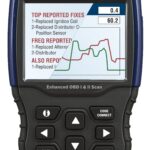Maintaining the cooling system in your 2000 BMW E46 is crucial for engine health and longevity. A common issue, especially after coolant work, is trapped air in the system. This can lead to overheating and inaccurate temperature readings. While your BMW E46’s temperature gauge is buffered to stay at the 12 o’clock position within a broad temperature range, actual overheating can still occur without being immediately obvious. Using an OBD2 scanner can help monitor real-time engine temperature for a more precise understanding of your engine’s condition, but proper bleeding is the first critical step. Here’s how to effectively bleed the cooling system on your BMW E46 2000.
Step-by-Step Guide to Bleeding Your BMW E46 Cooling System
Follow these steps to ensure your BMW E46 2000 cooling system is properly bled and free of air pockets.
-
Elevate the Front of Your BMW: Use ramps or a jack to raise the front of your E46 at least one foot higher than the rear. This elevation makes the radiator and bleed screw the highest points, allowing air to escape more easily. This is a simple yet effective technique for gravity-assisted bleeding.
-
Open the Bleed Screw and Add Coolant: Locate the bleed screw on your BMW E46 (typically on or near the thermostat housing or radiator). With the bleed screw open, slowly add the correct BMW-compatible coolant into the expansion tank until coolant starts to flow out of the bleed screw, free of air bubbles. This indicates coolant is reaching the highest point of the system and pushing air out.
-
Start Engine, Set Heater to Max, and Continue Bleeding: Leave the expansion tank cap off or loosely placed. Set your heater to the maximum temperature and fan speed. This opens up the heater core circuit in the cooling system. Start the engine and let it warm up to operating temperature. As the engine warms, periodically crack open the bleed screw to release any trapped air. Top off the coolant in the expansion tank as needed to maintain the level.
-
Rev Engine and Final Bleed: Once the engine is at operating temperature, increase the engine speed to 2000-2500rpm for a few seconds, repeating this several times. This increased flow rate can help dislodge stubborn air pockets. After revving, crack the bleed screw again until no more air escapes, and only coolant flows out. At this point, your heater should be blowing hot air, confirming that the heater core is filled with coolant and part of the cooling circuit is properly bled. You may need to repeat this revving and bleeding process a few times to remove all air effectively.
-
Cool Down and Re-Check: After bleeding, take your BMW E46 for a short drive. Allow the engine to cool down completely, then re-check the bleed screw for any residual air. Over the next few days, it’s normal to find very small amounts of air (just a few bubbles) escaping from the bleed screw. Regularly checking and bleeding ensures a properly functioning cooling system.
By following these steps, you can effectively bleed the cooling system on your 2000 BMW E46, helping to prevent overheating and maintain optimal engine performance. Remember to always use the correct BMW-approved coolant for your E46 to ensure compatibility and protection against corrosion.

